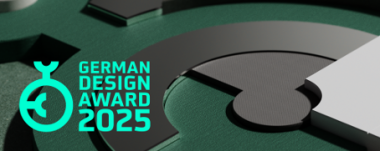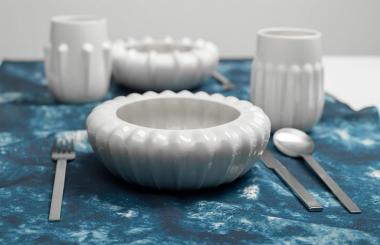German Design Award 2025: „Design muss Teil der Unternehmensstrategie werden“
Die Ergebnisse der Studie „Design in Business" des German Design Council – Rat für Formgebung wurden am 7. Februar im Rahmen der Award Show des German Design Award 2025 der Öffentlichkeit vorgestellt.
Der German Design Award prämiert innovative Lösungen, die sich den globalen Herausforderungen wie Ressourcenknappheit, Umweltverschmutzung und Klimawandel widmen. Die bestehenden Kategorien Produkt-, Kommunikationsdesign und Architektur werden in diesem Jahr erstmalig durch die neue Kategorie „Circular Design“ ergänzt. Im Rahmen der Preisverleihung, die als eines der wichtigsten internationalen Branchentreffen für Designer*innen gilt, wird zudem die „Personality of the Year“ geehrt sowie die Auszeichnung „German Design Award Newcomer” vergeben. Im Vorfeld der Preisverleihung wird erstmals die Studie „Design in Business“ des German Design Council vorgestellt. Die Ergebnisse beleuchten, wie Design Unternehmen hilft, sich den globalen Herausforderungen von Digitalisierung, Klimawandel und gesellschaftlichem Wandel zu stellen.
Design als strategische Ressource
Seit seiner Gründung 1953 setzt sich der German Design Council dafür ein, Design als Innovationsmotor und Wettbewerbsvorteil zu etablieren. Die neue Studie „Design in Business“ untermauert, wie essenziell Design für den Unternehmenserfolg ist. Studienteilnehmer wie Viessmann Climate Solutions, Canyon Bicycles und Drägerwerk AG nutzen Design strategisch, um Innovationen voranzutreiben, sich im Wettbewerb zu differenzieren und nachhaltige Lösungen zu entwickeln.
Forderung: Design muss Teil der Unternehmensstrategie werden
Die Studie macht deutlich, dass das Potenzial von Design oft ungenutzt bleibt. 79 % der befragten Unternehmen sehen Design als entscheidend für die Differenzierung. Aber nur 45 % setzen Designer*innen gezielt für strategische Aufgaben ein. Noch geringer ist der Anteil von Design in Führungspositionen: Hier sind lediglich 25 % der Designer*innen an Entscheidungsprozessen beteiligt. Unternehmen wie VAUDE oder Bosch Home Comfort Group zeigen jedoch, wie eine tiefere Integration von Design transformative Effekte entfalten kann.
Die Ergebnisse der Studie führen zu einer klaren Forderung: Design muss in allen Unternehmensbereichen strategisch verankert werden. Nur so kann das volle Potenzial von Design als Ressource für wirtschaftlichen Erfolg und gesellschaftlichen Wandel entfaltet werden.
Die Highlights des German Design Award 2025
Seit seiner Einführung im Jahr 2012 ist der German Design Award ein verlässlicher Indikator für die zentralen Bewegungen und Entwicklungen in der internationalen Designlandschaft. Mit der jährlichen Auszeichnung schafft der German Design Council eine Plattform, die die transformative Kraft von Design sichtbar macht und dessen Bedeutung für Wirtschaft und Gesellschaft unterstreicht. Hier demonstrieren visionäre Projekte und Persönlichkeiten eindrucksvoll die Dynamik und Potenziale von Design.
Die neue Kategorie „Circular Design“ stellt nachhaltige und zukunftsweisende Ansätze in den Mittelpunkt. Sie zeigen, wie Design nicht nur Produkte, sondern ganze Geschäftsmodelle transformiert. „Prämierte Projekte sind Leuchttürme für die Industrie und inspirieren dazu, Design als strategisches Instrument zu nutzen“, erklärt Lutz Dietzold, Geschäftsführer des German Design Council.
Mit der Auszeichnung von Kate Raworth und dem Doughnut Economics Action Lab (DEAL) als „Personality of the Year“ ehrt der German Design Award 2025 eine Vision, die nicht nur Theorie bleibt, sondern weltweit Städte, Unternehmen und Gemeinschaften aktiv dazu anregt, wirtschaftliche Innovationen nachhaltig und gerecht zu gestalten. Ihr Modell verbindet soziale Gerechtigkeit mit ökologischer Verantwortung und setzt neue Maßstäbe für ein wirtschaftliches Denken, das die planetaren Grenzen nicht nur respektiert, sondern als Chance begreift, zukunftsfähige Lösungen zu entwickeln.
Ebenso beeindruckend ist die Wahl von Juni Sun Neyenhuys zum „Newcomer of the Year 2025“. Ihre Forschung an algenbasierten Biomaterialien ist mehr als ein kreativer Impuls – sie zeigt, wie visionäres Design und Materialinnovation die Modeindustrie revolutionieren können. Diese Auszeichnung unterstreicht, dass der German Design Award nicht nur etablierte Visionen würdigt, sondern auch den Mut und die Kreativität junger Talente fördert, die mit ihren Ideen die Grenzen des Designs verschieben. Der Newcomer Award ist einer der wichtigsten internationalen Preise für außergewöhnliche Leistungen von jungen Design-Talenten. Die mit 15.000 Euro dotierte Auszeichnung, gesponsert von der Deutsche Telekom AG, unterstreicht die Bedeutung aufstrebender Talente für die Zukunft der Designbranche.
German Design Award
Rat für Formgebung

































